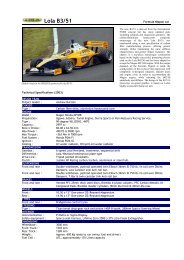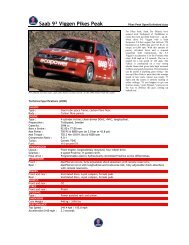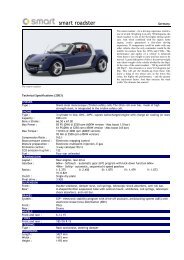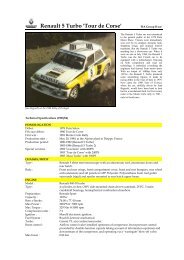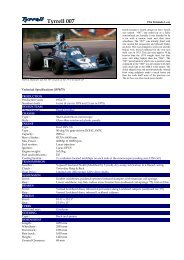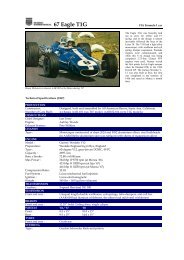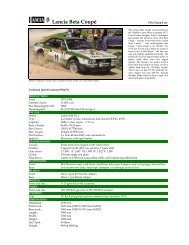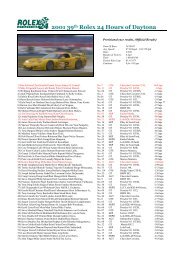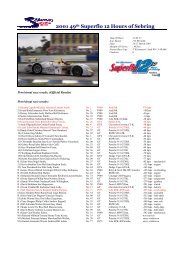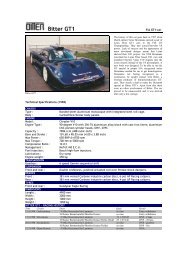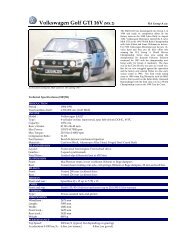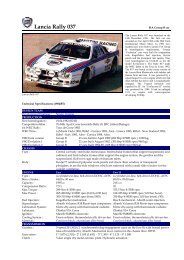70 Chaparral 2J - Motorsports Almanac
70 Chaparral 2J - Motorsports Almanac
70 Chaparral 2J - Motorsports Almanac
Create successful ePaper yourself
Turn your PDF publications into a flip-book with our unique Google optimized e-Paper software.
from Troutman and Barnes in California. One of those was at the BRIC, too.) So few, really? Well, <strong>Chaparral</strong> Cars was<br />
small, efficient and unromantic, and kept turning one car into another. There were three fiberglass-chassied roadsters<br />
originally called <strong>Chaparral</strong> 2s (only later dubbed 2A by outsiders, when subsequent models appeared). After three<br />
highly successful SCCA seasons, 1963-65, two of those were given roofs and big-block Chevys to make them into 2D<br />
coupes for FIA endurance racing in 1966; a D won the 1000-K at Germany’s old Nurburgring. Then one of those Ds and<br />
the remaining 2(A) became 1967’s 2F coupes; one took victory at Brands Hatch in England. Three chassis, seven race cars.<br />
Rogers has now turned one of those Fs back into the “A” Hall drove at the BRIC; it happens to be the one that took the<br />
12 Hours of Sebring in that form in 1965. The remaining 2F, the Brands winner, was on display only. Similarly, a series<br />
of aluminum-monocoque sports racers began with 1965’s 2C. That was modified into the first 2E, the winged car that<br />
startled the world in the inaugural Can-Am season in 1966. The same chassis later became the big-block 2G for 1967<br />
and ’68. It was this in which Hall suffered a career-ending accident at a Las Vegas track called Stardust. Heavily<br />
damaged, that’s the one chassis that was finally scrapped, according to Rogers. “Jim couldn’t even look at a picture of it<br />
without getting the shakes.” The second 2E, winner of <strong>Chaparral</strong>’s only Can-Am victory (Laguna Seca, 1966), was at<br />
Road America and Hall briefly demonstrated that too. Totals: two more chassis, four more “cars.” Left home along with<br />
the restored 2D was the unloved 2H, 1969’s infamous “white whale” quasi-coupe, known fairly or not as Hall’s only<br />
failure. But present with honor was the <strong>2J</strong>, the notorious, controversial Ground Effects Vehicle, or Sucker Car, of 19<strong>70</strong>.<br />
That one worked so well it was promptly banned. The seventh <strong>Chaparral</strong> chassis, it was to be the last of the <strong>Chaparral</strong><br />
sports car line. Later there were some 2K single-seaters, which brought ground effects to Indianapolis and took the 500<br />
in 1980. Wait a minute—haven’t we left out a <strong>Chaparral</strong> 2B? Yes, there’s a car in Hall’s collection called that, but it isn’t<br />
really a <strong>Chaparral</strong>. It was built as a research project by Jim’s engineer friends in Chevy R&D. Tested extensively at<br />
Rattlesnake, it taught both parties a lot, and led to Hall’s choice of aluminum for the 2C chassis. This was only one<br />
example of the clandestine cooperation between <strong>Chaparral</strong> and Chevrolet. Another was the Sucker, which began life in<br />
Detroit as another Chevy experiment. Rogers has to patiently explain all this over and over. He too must be incredulous<br />
about the crowds clustering around the four plain white old cars he’s minding. For so long, they were so secret. For<br />
decades, the public rarely saw them. Hasn’t everybody forgotten? Not likely. True significance has a way of living on,<br />
and besides, this setting points out the magnitude of <strong>Chaparral</strong>’s accomplishments in its day. A featured race for vintage<br />
Can-Am cars has brought together a good sampling of Road Runner rivals—would-be rivals. The most casual look at<br />
them shows how conservative, how conventional, how pedestrian, were so many creative minds in the racing world<br />
outside Jim Hall’s fence. Many are good race cars, arguably even better race cars, because they won more races. But...<br />
But they don’t stand tall in the mind like the tall white Road Runners from the barren Texas plains.<br />
JIM HALL<br />
Born in Texas in 1935 and raised in Colorado and New Mexico, young Jim Hall was a student at the California Institute<br />
of Technology in Pasadena, Calif., when he started driving his brother's Austin Healey sports car at weekend road races<br />
in 1954. That led to the purchase of a state-of-the-art modified sports car from the best builders in the business in 1961,<br />
but the results didn't satisfy him. Hall set up his own race car building operation. Thus was born <strong>Chaparral</strong> Cars of<br />
Midland, Texas. During the years from 1963, when the first <strong>Chaparral</strong> 2 was built, to 19<strong>70</strong>, Hall's engineering genius<br />
with enthusiastic help from General Motors technicians turned out a series of dramatic race car inventions that have left<br />
a lasting impact on the sport of motor racing. First came the ultra-light chassis, which some called the all-plastic car, but<br />
which was a chassis built completely of reinforced fiberglass. Then Hall staggered his competition with a high-mounted<br />
wing that rode horizontal down the straightaways but was tilted down in the turns when the driver released a pedal,<br />
giving him extra downforce in the corners. That innovation was banned when the competition cried, "Unfair." What<br />
followed was the fixed wing, which became Hall's trademark. Today's winged race cars are the evolution of Hall's<br />
design statement. Hall had already introduced a competitive advantage so subtle that drivers didn't know what it was<br />
for half a season — an automatic transmission for road racing. With it, Hall and his team drivers could steer efficiently<br />
through corners without taking either hand off the wheel to shift gears. The most radical was yet to come — the<br />
"vacuum cleaner" <strong>Chaparral</strong> <strong>2J</strong>, described by one writer as looking like it was still in its packing case. Boxy in<br />
appearance, it sailed at incredible speeds through the corners, thanks to an auxiliary motor that created a vacuum under<br />
the car to increase traction. While it never won a race, it too was banned in response to competitive outcry. Hall,<br />
meanwhile, kept his best secrets to himself. He developed methods of testing at Rattlesnake Raceway that gave him data<br />
about what the car was doing at various sections of the track. By contrast, his competitors were satisfied with the lap<br />
times their stop watches were giving them. Working with Chevrolet engineers, Hall probably advanced the technology<br />
of racing more than any race car designer in that period. That may have been what prepared him for one of the most<br />
significant jumps in technology that Indy car developers have taken in the second half of this century —introduction of<br />
the Pennzoil <strong>Chaparral</strong>, Indy car racing's first "ground effects" car, in 1979. A year later his driver Johnny Rutherford<br />
won the Indy 500 and four other races, which combined with other top finishes gave him the first-ever combination of a<br />
CART PPG Cup IndyCar World Series championship and a U. S. Auto Club title. It also made Rutherford the consensus<br />
U. S. "driver of the year." Hall left Indy car racing in 1982 to concentrate on his other business interests but returned to<br />
the sport in 1991 with another bright yellow Pennzoil-sponsored car. Pennzoil persuaded Hall to return to Indy car<br />
racing after an absence of eight years. It began with a victory in the first race when John Andretti won for Jim Hall in<br />
Australia.



